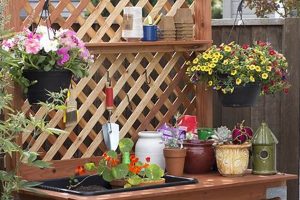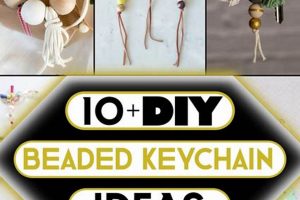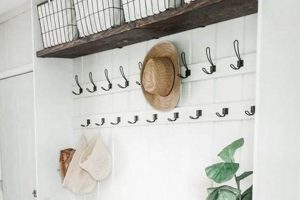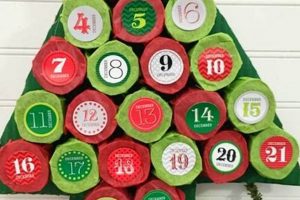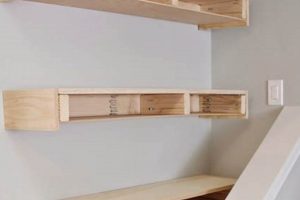The core concept revolves around creative concepts for constructing water features by oneself, utilizing readily available materials and personal ingenuity. An example would be transforming stacked terracotta pots into a tiered cascade, powered by a small submersible pump.
This approach to landscape design offers several advantages, including cost-effectiveness, personalization, and environmental responsibility through the reuse of existing resources. Historically, self-made decorative water elements have been prevalent across various cultures, reflecting resourcefulness and artistic expression.
The ensuing discussion will explore various facets of this practice, from design considerations and material selection to construction techniques and maintenance strategies, providing a framework for successful implementation.
Practical Guidance for Water Feature Construction
The following recommendations aim to improve the success rate of do-it-yourself water feature projects, covering aspects from initial planning to long-term care.
Tip 1: Plan for Adequate Water Containment: Ensure the chosen reservoir or liner is appropriately sized to accommodate the water volume and prevent leakage. Undersized containers or improperly sealed liners can lead to water loss and potential damage to surrounding areas.
Tip 2: Select a Suitable Pump: The pump’s flow rate should be compatible with the size and design of the feature. A pump that is too powerful can create excessive splashing, while one that is underpowered may not provide sufficient water circulation.
Tip 3: Prioritize Accessibility for Maintenance: Design the feature with easy access to the pump and other mechanical components for cleaning and repairs. Difficult access can discourage regular maintenance, leading to operational problems.
Tip 4: Incorporate Filtration: A filtration system, such as a simple screen or a more elaborate filter, can remove debris and algae, helping maintain water clarity and prevent pump clogging.
Tip 5: Consider Sunlight Exposure: Excessive sunlight can promote algae growth. Locate the feature in a partially shaded area or implement strategies to mitigate sunlight exposure, such as using aquatic plants.
Tip 6: Utilize Weather-Resistant Materials: Select materials that can withstand exposure to the elements, including temperature fluctuations, UV radiation, and moisture. Non-resistant materials can degrade quickly, requiring frequent repairs or replacements.
Tip 7: Ensure Proper Electrical Safety: All electrical connections should be made by a qualified electrician and adhere to local electrical codes. Ground fault circuit interrupters (GFCIs) are essential for preventing electrical shocks.
Tip 8: Account for Winterization (in Cold Climates): In regions with freezing temperatures, proper winterization procedures are crucial to prevent damage to the feature. This may involve draining the water, removing the pump, and protecting vulnerable components.
Adherence to these guidelines can significantly increase the longevity and enjoyment of a self-constructed water feature, while minimizing potential problems and maintenance requirements.
The subsequent sections will delve into specific design considerations and troubleshooting strategies to further enhance the success of these projects.
1. Material Selection
Material selection is a foundational element in the execution of self-constructed water features. The chosen materials directly influence the fountain’s aesthetic appeal, structural integrity, and long-term operational effectiveness. Inadequate material choices can lead to premature failure, water leakage, or aesthetic degradation, undermining the entire project. For instance, using untreated wood in direct contact with water will inevitably result in rot and structural collapse, whereas employing UV-resistant plastics for exposed components will extend their lifespan. Concrete, stone, and certain metals offer durability but require appropriate sealing or coatings to prevent erosion and water damage.
The selection process must consider the specific environmental conditions to which the water feature will be exposed. In regions with frequent freeze-thaw cycles, materials prone to cracking or expansion should be avoided. Similarly, areas with high mineral content in the water may necessitate the use of corrosion-resistant materials. Practical application involves evaluating the compatibility of different materials within the fountain’s design. Combining dissimilar metals, for example, can lead to galvanic corrosion. The weight and load-bearing capacity of the supporting structure must also be accounted for when choosing heavy materials like stone or concrete.
Ultimately, informed material selection is paramount for ensuring the longevity and visual appeal of a self-made water feature. A thorough understanding of material properties, environmental factors, and structural requirements is crucial for mitigating potential risks and achieving a successful outcome. Addressing these challenges proactively contributes to the overall sustainability and enjoyment derived from the project, highlighting material selections central role within the broader concept of fountain ideas diy.
2. Pump Specifications
Pump selection constitutes a critical phase in the successful realization of do-it-yourself water features. The pump’s characteristics directly govern the water flow rate, display height, and overall operational efficacy. Incorrect pump specifications will result in suboptimal performance, potentially compromising the intended aesthetic and functional attributes of the fountain.
- Flow Rate (Gallons Per Hour – GPH)
Flow rate, measured in gallons per hour (GPH), dictates the volume of water circulated within the fountain system. A pump with an insufficient flow rate will produce a weak or nonexistent water display. Conversely, an excessively high flow rate can lead to undesirable splashing and excessive water consumption. Determining the optimal flow rate necessitates careful consideration of the fountain’s size, design, and desired water effect. Example: A tiered fountain requires a higher GPH than a simple bubbler.
- Head Height (Vertical Lift)
Head height refers to the maximum vertical distance a pump can effectively lift water. This specification is paramount for fountains incorporating elevated water features, such as waterfalls or spouts. If the pump’s head height is inadequate, the water will not reach the intended elevation, resulting in a compromised visual display. The selection of an appropriate head height necessitates precise measurement of the vertical distance from the pump’s location to the highest point of the water feature. Real world scenario: A pump intended for a 3-foot waterfall must have a head height exceeding 3 fe
et to compensate for friction losses within the plumbing. - Submersible vs. External Pumps
Submersible pumps are designed for underwater operation, offering simplified installation and concealment. External pumps, located outside the water reservoir, provide easier access for maintenance and can handle larger water volumes. The choice between these pump types depends on factors such as the fountain’s size, design, and maintenance accessibility. Submersible pumps are commonly used in smaller fountains, while external pumps are favored for larger, more complex water features. Considering this dichotomy is crucial for a seamless “fountain ideas diy” endeavor.
- Power Consumption and Efficiency
A pump’s power consumption directly influences the operational cost of the fountain. Selecting an energy-efficient pump can significantly reduce electricity bills and minimize environmental impact. Power consumption is typically measured in watts, with lower wattage pumps generally being more energy-efficient. Evaluating the pump’s energy efficiency rating is crucial for making an informed decision, particularly for fountains intended for continuous operation. Using a low wattage pump for “fountain ideas diy” ensures responsible resource utilization.
The integration of these pump specifications into the design and construction phase is central to realizing the intended outcome of “fountain ideas diy”. Neglecting these crucial factors will almost certainly result in a water feature that fails to meet expectations. Thoughtful consideration of these elements contributes to a successful and sustainable outcome, allowing enthusiasts to create personalized water displays that seamlessly blend functionality and aesthetic appeal.
3. Waterproofing Measures
Waterproofing measures are integral to the successful construction of self-made water features. Inadequate waterproofing leads to water loss, structural damage, and potential harm to surrounding environments, thereby negating the aesthetic and functional benefits of the “fountain ideas diy” approach. Effective waterproofing ensures the longevity and operational efficiency of these installations.
- Liner Selection
The selection of an appropriate liner material constitutes a primary waterproofing measure. Options include flexible pond liners (e.g., EPDM rubber), rigid pre-formed liners, and concrete coatings. Flexible liners conform to irregular shapes and offer puncture resistance. Rigid liners provide structural support. Concrete coatings, when properly applied, create a seamless waterproof barrier. Choosing the correct liner type depends on the fountain’s design, scale, and budget. For example, a large, irregularly shaped pond benefits from a flexible EPDM liner, while a small, formal fountain might utilize a pre-formed rigid liner. Liners failing to fully contain the water will damage surrounding property with water waste.
- Seam Integrity
Ensuring the integrity of seams and joints is crucial, particularly when using flexible liners. Overlapping and sealing liner sections creates a continuous waterproof membrane. Seam failures result in leaks, compromising the entire waterproofing system. Specialized adhesives and sealing tapes are employed to create robust, watertight bonds between liner sections. Proper seam preparation, including cleaning and drying the liner surfaces, is essential for achieving durable seals. Neglecting seam integrity will make a DIY project unsustainable.
- Penetration Management
Managing penetrations, such as plumbing and electrical conduits, through the waterproofing membrane requires careful attention. Penetrations create potential pathways for water leakage. Specialized fittings and sealants are used to create watertight seals around these penetrations. For instance, a bulkhead fitting can provide a secure and waterproof connection for a pipe passing through a liner. The application of waterproof sealant around the fitting further enhances its leak-proof properties. These are important factors when implementing “fountain ideas diy.”
- Surface Preparation
Adequate surface preparation is paramount for achieving effective waterproofing. The substrate beneath the waterproofing membrane must be clean, dry, and free from sharp objects or debris that could puncture or damage the membrane. Uneven surfaces can create stress points, leading to premature failure. Compacting soil, applying a geotextile underlayment, or smoothing concrete surfaces are examples of surface preparation techniques. These techniques ensures the successful application of a waterproof barrier, extending the life of the water feature.
The implementation of these waterproofing measures, from liner selection to surface preparation, is crucial for safeguarding the structural integrity and aesthetic appeal of self-made water features. Integrating these considerations into the planning and execution of “fountain ideas diy” projects ensures lasting enjoyment and minimizes the risk of costly repairs or environmental damage. Overlooking these aspects undermines the objectives of DIY water features.
4. Filtration System
A filtration system is a critical component in the context of self-made water features. Its integration directly affects water clarity, system longevity, and maintenance frequency. The absence of adequate filtration results in the accumulation of debris, algae growth, and potential damage to the pump, leading to frequent cleaning interventions and reduced operational lifespan. For example, a fountain situated beneath trees, without a filtration system, will rapidly accumulate leaves and other organic matter, clouding the water and potentially clogging the pump intake. The incorporation of a filtration system mitigates these issues.
Effective filtration systems within do-it-yourself fountains range from simple mechanical filters, such as screens or sponges, to more complex biological filters. Mechanical filters remove particulate matter, while biological filters utilize beneficial bacteria to break down organic pollutants. The choice of filtration method depends on the fountain’s size, location, and intended use. A small, indoor fountain might require only a simple sponge filter, whereas a larger, outdoor pond-style fountain could benefit from a multi-stage filtration system incorporating both mechanical and biological elements. Real-world instances include repurposing household items, such as plastic containers and filter media, to create cost-effective filtration solutions. Practical understanding of these dynamics is pivotal for successfully implementing “fountain ideas diy.”
The proper functioning of a filtration system is essential for maintaining a visually appealing and ecologically balanced water feature. Regular maintenance, including cleaning or replacing filter media, is necessary to ensure optimal performance. The selection and implementation of an appropriate filtration system represent a significant challenge within the realm of self-constructed water fountains. Successful integration, however, directly translates to reduced maintenance, improved water quality, and extended system longevity, thereby enhancing the overall enjoyment and sustainability of do-it-yourself water feature projects. Proper filtration is therefore vital to the success of “fountain ideas diy.”
5. Sunligh
t Mitigation
Sunlight mitigation is a crucial consideration within the sphere of “fountain ideas diy.” Uncontrolled solar exposure fosters algae proliferation, elevates water temperature, and accelerates evaporation, thereby compromising both the aesthetic appeal and the functional efficiency of self-made water features. Strategic mitigation techniques are therefore essential for ensuring the longevity and operational integrity of these projects.
- Strategic Placement
Strategic placement involves situating the fountain in a location that receives partial shade during peak sunlight hours. This reduces the intensity of solar radiation impinging upon the water surface, inhibiting algae growth and lowering water temperature. Examples include positioning the fountain beneath a deciduous tree or adjacent to a structure that casts a shadow during midday. Incorrect placement can negate this strategy. Choosing an area with excessive sunlight exposure will necessitate more intensive mitigation efforts.
- Aquatic Vegetation
Aquatic vegetation offers a natural means of shading the water surface and competing with algae for essential nutrients. Floating plants, such as water lilies or water hyacinths, create a canopy that reduces sunlight penetration. Submerged plants, like eelgrass, absorb nutrients that would otherwise fuel algae growth. Successful implementation hinges on selecting appropriate plant species and maintaining a balance between plant cover and open water surface. An overabundance of aquatic vegetation can impede water circulation and create anaerobic conditions.
- Water Dyes and Shading Agents
Water dyes and shading agents are commercially available products designed to reduce sunlight penetration by absorbing or reflecting light. These products are typically non-toxic and safe for aquatic life when used according to manufacturer instructions. The application of water dyes can impart an artificial color to the water, which may be aesthetically desirable or undesirable depending on individual preferences. It is vital to note that over-application of these agents can negatively affect water quality and visibility. Some dyes are specially formulated to filter UV light.
- Physical Barriers
Physical barriers, such as shade sails or floating covers, provide a direct means of blocking sunlight from reaching the water surface. Shade sails are suspended above the fountain, creating a shaded area. Floating covers, constructed from materials like plastic mesh, float on the water surface, providing a physical barrier to sunlight. The efficacy of physical barriers depends on their size, material, and orientation relative to the sun’s path. An improperly sized shade sail may fail to provide adequate shade during certain times of the day. Physical barriers may conflict with the intended aesthetic of the fountain.
These sunlight mitigation techniques, when judiciously applied, significantly enhance the long-term viability and aesthetic appeal of self-made water features. A comprehensive strategy combining multiple methods often yields the most effective results. The integration of sunlight mitigation into the design and construction phases of “fountain ideas diy” demonstrates a commitment to sustainable practices and responsible water management.
6. Electrical Safety
Electrical safety is paramount in the design and implementation of self-constructed water features. The inherent combination of water and electricity presents substantial risks, demanding meticulous adherence to safety protocols to prevent injury or equipment damage.
- Ground Fault Circuit Interrupters (GFCIs)
GFCIs are indispensable safety devices designed to detect minute imbalances in electrical current, indicating a potential ground fault. Upon detection, the GFCI rapidly interrupts the power supply, mitigating the risk of electric shock. Integration of GFCIs in all electrical circuits serving the water feature is mandatory. An example scenario involves a submerged pump with compromised insulation; the GFCI would trip, preventing electrocution. GFCIs are not optional; their absence poses a tangible threat to safety in “fountain ideas diy”.
- Waterproof Connections and Wiring
The use of waterproof connectors and appropriately rated wiring is essential to prevent water intrusion and subsequent electrical hazards. Submersible pumps and lighting fixtures necessitate sealed connections to prevent short circuits and electrical leakage. Wiring should be buried in conduit or otherwise protected from physical damage. Improperly sealed connections provide a direct pathway for water to contact electrical components, creating a potentially lethal situation. Waterproofing compounds approved for submerged electrical applications are a necessity for “fountain ideas diy”.
- Proper Grounding
Effective grounding establishes a low-resistance path for fault currents to return to the source, facilitating the operation of overcurrent protection devices such as circuit breakers. All metallic components of the water feature, including pumps, lighting fixtures, and metal framework, should be properly grounded. Inadequate grounding can result in elevated touch potentials, increasing the risk of electric shock. A grounding rod driven into the earth provides a direct connection to ground potential. Grounding ensures the safety of “fountain ideas diy”.
- Adherence to Electrical Codes
Compliance with local electrical codes and regulations is non-negotiable. These codes provide specific guidelines for the safe installation of electrical equipment in and around water features. Permits may be required for electrical work, and inspections are often conducted to ensure code compliance. Failure to adhere to electrical codes can result in fines, project delays, and, most importantly, increased risk of electrical hazards. Local codes ensure the legal and safe implementation of “fountain ideas diy”.
The implementation of these electrical safety measures is non-discretionary when pursuing self-constructed water features. Failure to prioritize electrical safety creates unacceptable risks and jeopardizes the well-being of individuals and the integrity of property. “Fountain ideas diy” inherently requires a robust understanding and unwavering adherence to electrical safety principles.
7. Winterization (if applicable)
In regions subject to freezing temperatures, winterization assumes a pivotal role in the successful long-term operation of self-constructed water features. Failure to implement proper winterization protocols can result in significant damage to fountain components, necessitating costly repairs and potentially rendering the feature unusable.
- Water Drainage and Component Removal
Complete drainage of the fountain’s water reservoir is paramount. Residual water can freeze and expand, causing cracks in the basin, plumbing, and surrounding structures. Submersible pumps and filters should be removed, cleaned, and stored indoors in a frost-fre
e environment. For instance, neglecting to drain a concrete birdbath can lead to extensive cracking during winter, requiring complete replacement. Draining the water and removing components protects “fountain ideas diy” from unnecessary damage. - Pipe Protection and Insulation
Exposed pipes and plumbing lines are particularly vulnerable to freezing. These should be insulated with pipe wrap or heat tape to prevent ice formation. Alternatively, pipes can be disconnected and drained to eliminate the risk of freezing. Neglecting this step can result in burst pipes, requiring extensive repairs. Proper insulation protects the piping within the “fountain ideas diy” design.
- Basin and Liner Protection
The fountain basin, especially if constructed from concrete or other porous materials, requires protection from freeze-thaw cycles. Covering the basin with a waterproof tarp or insulating material can help minimize the effects of temperature fluctuations. Liners, particularly flexible PVC liners, can become brittle in cold temperatures and are susceptible to cracking. Leaving a liner exposed and unprotected may cause damage, reducing the lifespan. Protecting the basin maintains the structural integrity of “fountain ideas diy”.
- De-Icers and Limited Operation
In some instances, maintaining limited fountain operation throughout the winter may be feasible, using submersible de-icers to prevent ice formation. However, this approach requires careful monitoring to ensure the de-icer functions effectively and that the pump does not freeze. This option is only viable in regions with moderately cold winters and demands constant supervision. If not properly controlled, the electricity used will negate the resourcefulness of “fountain ideas diy”.
The implementation of these winterization procedures, contingent upon geographic location and climate, is critical for preserving the functionality and aesthetic appeal of self-made water features. Neglecting these precautions can lead to costly repairs and diminished enjoyment of the “fountain ideas diy” investment.
Frequently Asked Questions
This section addresses common inquiries and concerns regarding the planning, construction, and maintenance of do-it-yourself water features, providing concise and informative responses.
Question 1: What constitutes the most critical factor in ensuring the longevity of a self-made fountain?
Effective waterproofing and the utilization of durable, weather-resistant materials are paramount for extending the lifespan of a self-constructed fountain.
Question 2: What measures should be taken to prevent algae growth in a water feature?
Implementing sunlight mitigation strategies, such as strategic placement in shaded areas or the introduction of aquatic vegetation, helps to minimize algae proliferation.
Question 3: How does one determine the appropriate pump size for a fountain project?
The pump’s flow rate (GPH) and head height should be carefully matched to the fountain’s design, accounting for the desired water display and any vertical lift requirements.
Question 4: What safety precautions must be observed when installing electrical components in a water feature?
Adherence to electrical codes, the use of Ground Fault Circuit Interrupters (GFCIs), and proper grounding are essential for preventing electrical hazards.
Question 5: Is filtration necessary for all self-made fountains?
While not always mandatory, a filtration system significantly improves water clarity and reduces maintenance frequency, particularly for outdoor water features.
Question 6: What steps are involved in winterizing a water feature in cold climates?
Winterization typically involves draining the water, removing the pump and other sensitive components, and protecting the basin from freeze-thaw damage.
These questions are indicative of the primary concerns encountered during the creation and upkeep of DIY water features. Addressing these issues proactively fosters a more successful project outcome.
The following section explores advanced design considerations and troubleshooting techniques to further enhance the knowledge base of water feature enthusiasts.
Conclusion
This exploration of “fountain ideas diy” has underscored the significance of meticulous planning, material selection, and adherence to safety protocols. Key areas of focus encompassed waterproofing, filtration, sunlight mitigation, electrical safety, and, where applicable, winterization. Successfully navigating these considerations is paramount to the creation of enduring and aesthetically pleasing water features.
The ongoing evolution of design principles and construction techniques offers opportunities for innovation within this domain. Further exploration of sustainable materials and energy-efficient technologies will undoubtedly shape the future of self-constructed water features, promoting both environmental responsibility and artistic expression. The informed application of these principles will lead to successful implementation.


